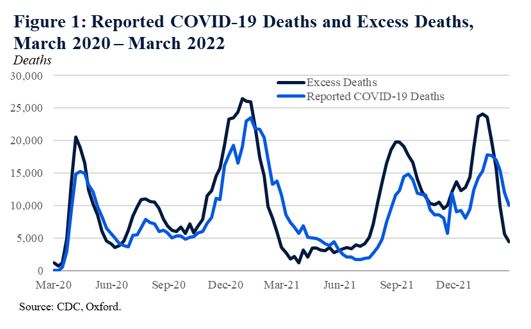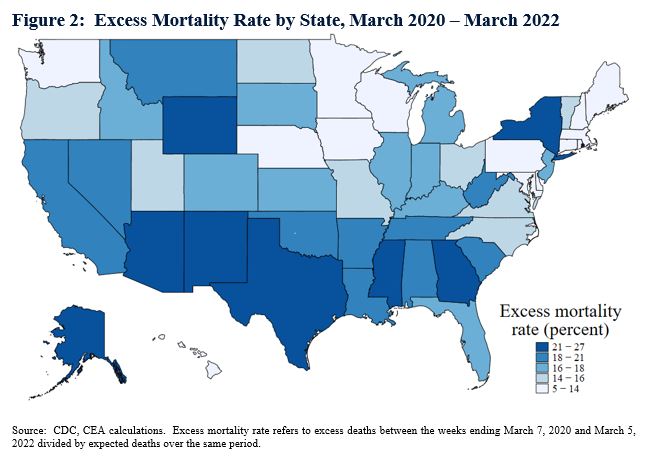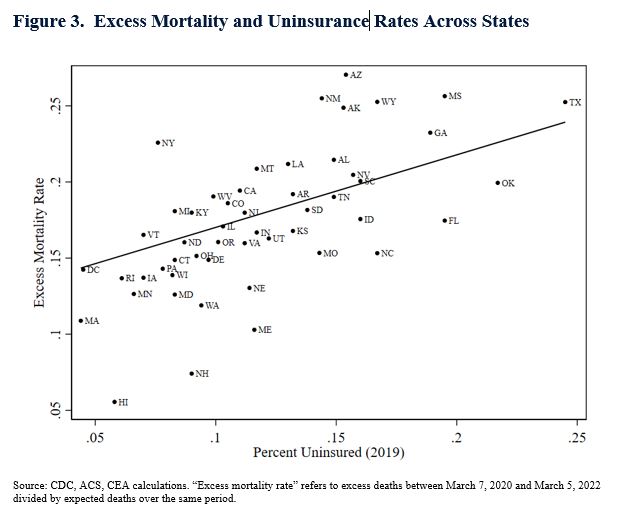Excess Mortality during the Pandemic: The Role of Health Insurance
Official estimates of deaths attributable to COVID-19 indicate that over 1 million Americans have lost their lives to COVID-19 since the first COVID-19 death was reported in the United States in March 2020. However, this staggering loss does not include any deaths caused by COVID-19 that were attributed to other causes. In addition, it does not include deaths that were indirectly the result of the pandemic but not caused by COVID-19 directly. For example, some people may have been unable to access prevention and treatment for other health conditions during the pandemic, leading to higher-than-expected mortality. Deaths may also have been averted during the pandemic due to, for example, lower risks of accidents or injuries as a result of pandemic-related mitigation measures.
This brief investigates how excess mortality varies across States and examines the role of health insurance coverage in explaining these differences. The evidence shows that lack of health insurance coverage is associated with higher excess mortality rates during the pandemic, even after controlling for differences in vaccination rates, the age distribution of the State, the share of the State population with pre-existing conditions, and the degree of each State’s restrictions during the pandemic. The findings suggest that lack of health insurance coverage may have generated more excess deaths in States with relatively low coverage rates.
Measuring excess mortality
Researchers have tried to quantify the total net mortality burden of the COVID-19 pandemic by examining how observed counts of deaths during a specific time period differ from the expected number of deaths during the same time period based on data prior to the pandemic. These “excess deaths” thus provide a measure of the extra number of deaths from all causes during the pandemic relative to what would have been expected had the pandemic not occurred.
The World Health Organization (WHO) recently released a report showing that the full death toll associated with the COVID-19 pandemic in 2020 and 2021 was approximately 14.9 million worldwide, much higher than the official death toll from COVID-19 reported over that time period, which was 5.42 million.
For the United States, the Centers for Disease Control and Prevention (CDC) estimates that excess deaths between the weeks ending March 7, 2020 and March 5, 2022 totaled 1,105,736, 15 percent more than the 958,864 official death toll from COVID-19 over that period.[1] Figure 1 shows excess deaths in the United States over time, along with reported deaths from COVID-19. As shown in the figure, while the number of excess deaths is correlated with reported COVID-19 deaths, in general, excess deaths exceed reported COVID-19 deaths.

The excess mortality rate, or the percentage increase in excess deaths relative to expected deaths, differs significantly across States, from a low of 5.7 percent in Hawaii to a high of 27.4 percent in Arizona, as shown in Figure 2. These differences are large; if every State had had the same excess mortality rate as Hawaii, about 780,000 fewer people would have lost their lives over this period.

Health insurance coverage and mortality
One factor that may have influenced the excess mortality rate during the pandemic is health insurance coverage, which could impact whether people received the care they needed during the pandemic, both for COVID-19 and non-COVID-19 ailments. Over a long period of time, high rates of uninsurance could also be associated with worse overall health of the underlying population, which could lead to greater vulnerability to severe illness from COVID-19. Indeed, there is evidence suggesting that increases in insurance coverage are associated with better self-reported health and fewer untreated chronic conditions.
Prior to the pandemic, in 2019, uninsurance rates for 19-64 year-olds across States varied widely, from a low of 4.4 percent in Massachusetts and a high of 24.5 percent in Texas. Figure 3 plots the excess mortality rate during the COVID-19 pandemic against the uninsurance rate in 2019, weighted by population. We see a strong positive association between the excess mortality rate and uninsurance: a 10 percentage point increase in uninsurance in 2019 is associated with a 4.8 percentage point increase in the excess mortality rate, which represents a 26 percent increase relative to the average excess mortality rate of 18.4 percent over the pandemic.

These findings suggest that higher shares of the population uninsured may have resulted in higher excess mortality rates over the last two years. Of course, there are several other factors not controlled for in these simple scatterplots that may explain why some areas had higher rates of excess deaths during the pandemic besides health insurance. Some of these correspond to differences in rates of COVID-19 illness, which have varied due to both State and local policies and individual behaviors, such as masking and social distancing. As of December 2021, COVID-19 vaccination rates also differ across regions, with 46.3 percent of the population fully vaccinated in Idaho and 77.5 percent of adults fully vaccinated in Vermont. Because COVID-19 vaccination provides a high degree of protection from severe illness and death, these differences could account for some of the variation in excess death rates across areas. In addition, other underlying differences in the population, like the age distribution, may have affected mortality rates during the pandemic. Thus, the relationships shown above may be confounded by these other factors to the extent that they are correlated with health insurance coverage.
While difficult to account for all of these potentially confounding factors, we measure the association between the pre-pandemic uninsurance rate and excess mortality at the State level after controlling for the vaccination rate in December 2021, the share of the State population over age 65, the share of the State population with pre-existing conditions, and a State’s level of pandemic restrictions in April 2021 as measured by WalletHub, and weight by State population. Our results indicate that these controls do not explain away the association between uninsurance and excess deaths: we find that a 10 percentage point increase in the uninsurance rate is still associated with a 4.8 percentage point increase in the excess mortality rate, and the relationship remains statistically strong after incorporating these factors.
These results are consistent with causal evidence on the relationship between mortality and health insurance more generally. For example, researchers have found that severely ill patients admitted to the hospital just over the age of 65, when they are more likely to be covered by health insurance through the Federal Medicare program, are 20 percent less likely to die within 7 days compared to a similar group just under the age of 65 (who have similar types of illnesses but are less likely to be covered by health insurance). In addition, evidence shows that near-elderly adults in States that expanded their Medicaid programs after the Affordable Care Act experienced 9.4 percent lower mortality compared to States that did not expand their Medicaid programs. This result implies that approximately 15,600 deaths could have been averted over a 4-year period if all States had elected to expand coverage through Medicaid.
While more work is needed to understand whether the relationship between health insurance coverage and excess mortality rates during the pandemic is causal and, if so, the underlying mechanisms behind these effects, our results suggest an important role for health insurance coverage in protecting populations during periods of high excess mortality.
Biden-Harris Administration policies to increase health insurance coverage
The Biden-Harris Administration has taken many steps to increase health insurance coverage that have accompanied a reduction in the uninsurance rate among 18-64 year olds, from 14.5 percent in the fourth quarter of 2020 to 13.1 percent one year later. This increase in health insurance coverage is in stark contrast to the trend during the prior four years, after the uninsured rate hit a low of 11.9 percent during the first quarter of 2016. These actions have included the American Rescue Plan’s expanded premium tax credits, which reduced premiums, increased savings, and provided consumers access to quality, affordable health care coverage through the Marketplaces. There were 3.1 million new consumers during the open enrollment period, about 2.8 million people enrolled in health care coverage during the Special Enrollment Period through the Marketplaces after these increased subsidies went into effect, and over 90 percent of these consumers saw their premiums go down due to the tax credits. In addition, President Biden signed an Executive Order in April 2022 to Strengthen Americans’ Access to Affordable, Quality Health Coverage, which directs agencies to review existing regulations and guidance to remove barriers to health insurance coverage.
However, more can be done to ensure that more people have access to high quality health insurance. Among the eight States with the highest share of their population uninsured, all eight had not expanded their Medicaid programs as of 2019.[2] As detailed in a previous CEA issue brief, Medicaid expansion is associated not only with an increase in insurance coverage, but also with improvements in health, as well as indirect effects such as gains in food and housing security and financial well-being. The findings above suggest that the increases in insurance coverage stemming from Medicaid expansion may also be important in protecting people during future pandemics.
Excess mortality during the pandemic varies considerably across States, and is higher among States with higher levels of uninsurance prior to the pandemic. These results are consistent with prior research that causally links health insurance with reductions in mortality and better treatment of chronic conditions. The findings in this brief suggest that higher rates of health insurance may have reduced excess mortality both by reducing risk factors associated with more severe COVID-19 disease and through improved treatment of those seeking care during the pandemic.
[1] More details regarding the CDC’s methodology in determining excess deaths is available here. Reported death toll from COVID-19 from Oxford data in Haver.
[2] One of these States, Oklahoma, expanded their Medicaid program following the June 30, 2020 passage of the Oklahoma Medicaid Expansion Initiative by a majority vote.

